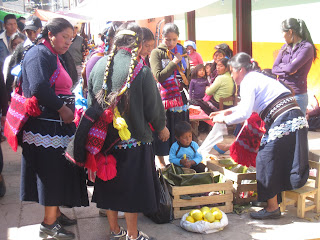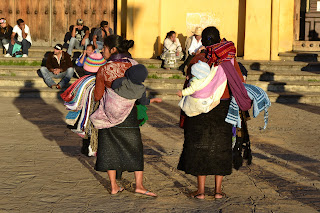A wrinkled medicine man in a white woollen tunic is waving a live chicken over the flames of a dozen candles, muttering prayers in Tsotsil. Next to him, a thin old woman sits hunched on pine needles, her long grey hair plaited with bright ribbons, her eyes melancholic. The medicine man turns to her and rubs the chicken slowly over her body. The bird gives one last squawk, before he twists its neck until it stops moving, and continues with his chant. The woman starts to cry.
From the outside, San Juan Chamula’s church looked like any other in Mexico: a Spanish-built whitewashed building, 3 bells set high into its façade, a white cross crowning the top. Technically, this is a Catholic church, but the Chamulans have only ever paid token respect to their Spanish conquerors. Passing through the heavy oak door was truly like entering another world.
There were no pews: the marble floor was entirely blanketed in pine needles, the smell of Christmas in the air. There was no silence: dozens of Chamulan families sat cross-legged: sitting, talking, eating, praying, crying, laughing, singing. Women dressed in purple silk shirts and heavy woollen skirts breastfed babies in their laps. A row of men, in black wool tunics with rainbow belts, prayed on their knees, crates of Coke and Sprite beside them. Hundreds of candles flickered from wooden altars which thronged every side of the church, hundreds more were pressed to the floor. Floral sheets were draped like teepees from the arched wooden rafters. Glass boxes lined the walls, bromeliads cascading over them, each one holding a large (somewhat tacky) plastic figure of a saint. No one seemed bothered by the tourists wandering, agog, amongst them – but there were strictly no photos allowed.
We were lucky to have Alex, an irrepressible guide from San Cristobal, to explain what was going on. He said the Mayans believe they have two souls. If you get sick, there’s something wrong with your animal soul. So you take an animal – like a chicken – to the medicine man, who transfers the illness from your body to the animal. The illness will die when the animal does. Alex explained that after people pray, they drink alcohol or fizzy drinks to make them burp to release their evil spirits. (Coke could be on to a marketing trick here...)
Stunned, we travelled on, over pine-clad hills, to Tenejapa, where the locals there had kept the pews in their church, but not much else in the way of Catholic tradition. We watched as a dozen men, the major domos, or leaders of the town, paraded up the isle in colourful embroidered shorts, black tunics, and thick-soled roman sandles. They wore stiff straw hats covered in silk ribbons of pink, orange, green and blue. Brilliant pink pom poms and chains of gold coins were draped around their necks. Each had an ox’s horn on a string slung over his shoulder. (Their prayers involve toasting each other with harsh liquor, more burping, and if they’re getting too hammered they tip the extra in their horns for later.) The major domos stopped to say hi as they filed out. Alex exchanged numbers with one of them, who pulled an iphone out of his tunic. Tradition and technology all in one.
We were ogled at as we went through the town market: amazingly I was a good head taller than anyone else, and Dan was a comparative giant. Alex led the way, buying roasted peanuts, sweet potatoes, tamales (meat and maize wrapped in a leaf) for us to try. We stopped to listen to a travelling salesman selling wood to add to tea to treat a sore throat. He had the full attention of a cluster of locals. As we left, they all started laughing. “What did he say?” we asked. “He said ‘Chicken Legs and the Germans are leaving’”, Alex replied, smiling. Alex, being a skinny Latino, was known as Chicken Legs. All foreigners were known Germans – thanks to some Germans being stationed on a farm near here during the war. Foreigners who wore sun glasses were dubbed ‘blind’ – no one has glasses here. We pushed ours back on our heads.
There was nothing familiar in the Mayan cemetery either, set right beside a soccer pitch where children played and sheep grazed. No one was buried in coffins. Each grave was a simple mound of dirt, covered in pine needles, with a wooden “door” on top, so the dead could make their way to the Underworld. In Mexico, death is not a time for mourning, but a celebration. Wooden crosses at each grave were not marked with birth dates – only the day someone died. On November 2, the Day of the Dead, people believe the spirit comes back. Locals celebrate at the graves with picnics, music, and partying. It was almost impossible to get your head around. Birth here is different too – the woman gives birth on a bed of pine needles, surrounded by all her family, with a local band playing, and fireworks! Then she gets up and makes a feast for everyone… no Birth Care for these mums.
The last village we visited, Zinacantan, felt totally different again. Known as the village of the flower people, there were green houses as far as the eye could see, producing roses, geraniums, bromeliads for export. The people had adopted the theme in their dress: they were distinguished by richly embroidered floral tunics, shawls and skirts. We ate lunch with a local woman, Maria, who pressed fresh tortillas from corn dough and cooked them on a fire in her small hut. Eaten with beans and crushed pumpkin seeds, they were delicious. There was just one room, and 9 people living there: I’m not sure how her newlywed son was getting on.
These were villages of simple beauty – but they were not without their problems. Alcoholism is rife here, thanks to the cheap liquor everyone produces. Despite government attempts at introducing medical advances, most women can’t be convinced to go to hospital if they need caesareans, so child mortality is still an issue. And then there are those who have rejected traditional religion. Many Chamulans have converted to other forms of Christianity, thanks to missionaries at work in the area. Those who do are expelled from the villages. A remarkable 40,000 of them – known as Los Expulsados - now live in shanty towns on the outskirts of San Cristobal. We saw many basic huts built into deforested hillsides that looked as if they were about to collapse. It was a sobering sight on our way back into town – after one of the most phenomenal days of the trip.










No comments:
Post a Comment